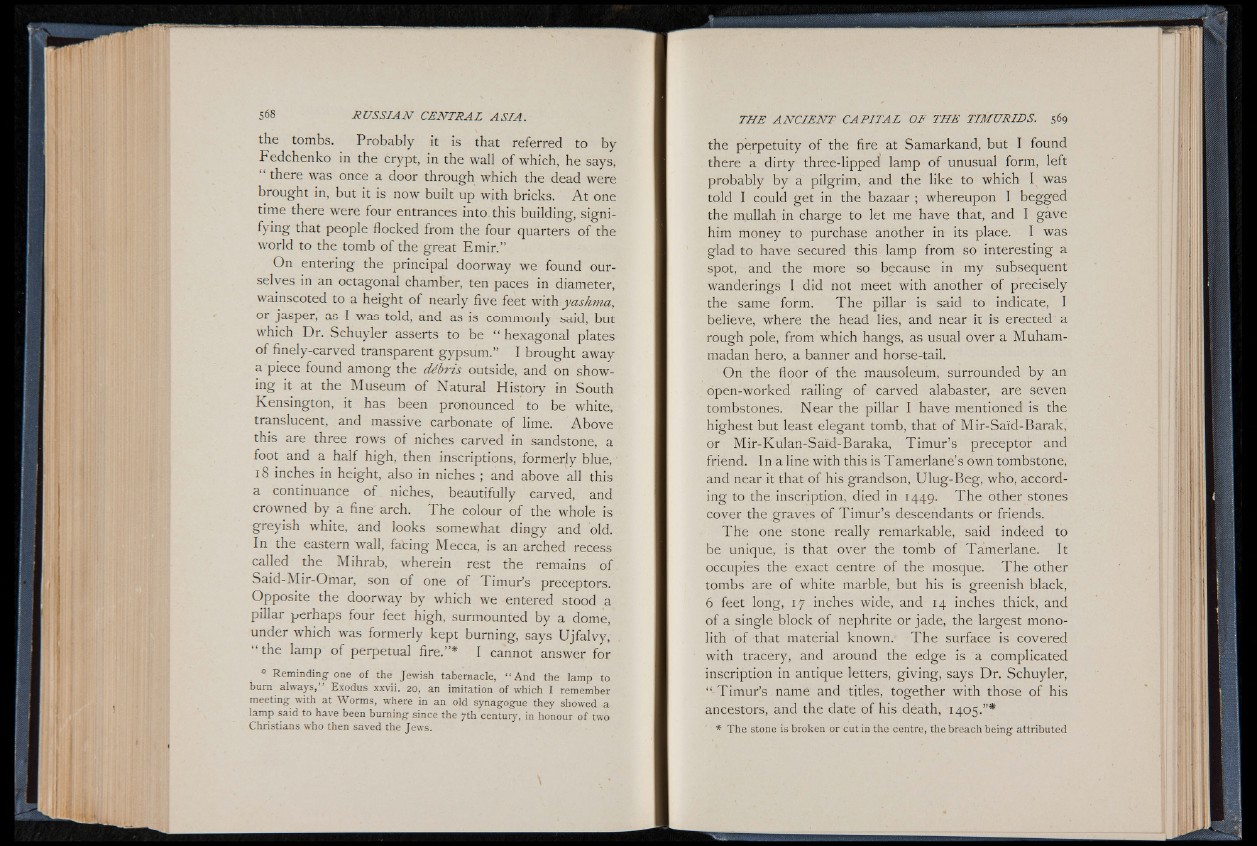
the tombs. Probably it is that referred to by
Fedchenko in the crypt, in the wall of which, he says*
“ there was once a door through which the dead were
brought in, but it is now built up with bricks. A t one
time there were four entrances into this building, signi-
fying that people flocked from the four quarters of the
world to the tomb of the great Emir.”
On entering the principal doorway we found ourselves
in an octagonal chamber, ten paces in diameter,
wainscoted to a height of nearly five feet with yashma,
or jasper, as I was told, and as is commonly said, but
which Dr. Schuyler asserts to be “ hexagonal plates
of finely-carved transparent gypsum.” I brought away
a piece found among the débris, outside, and on showing
it at the Museum of Natural History in South
Kensington, it has been pronounced to be white,
translucent, and massive carbonate qf lime. Above
this are three rows of niches carved in sandstone, a
foot and a half high, then inscriptions, formerly blue, '
18 inches in height, also in niches ; and above all this
a continuance of niches, beautifully carved, and
crowned by à fine arch. The colour of the whole is
greyish white, and looks somewhat dingy and old.
In the eastern wall, fating Mecca, is an arched recess
called the Mihrab, wherein rest the remains of
Said-Mir-Omar, son of one of Timur’s preceptors.
Opposite the doorway by which we entered stood a
pillar perhaps four feet high, surmounted by a dome,
under which was formerly kept burning, says Ujfalvy,
the lamp of perpetual fire.”* I cannot answer for
° Reminding one of the Jewish tabernacle, “ And the lamp to
bum always,” Exodus xxvii. 20, an imitation of which I remember
meeting with at Worms, where in an old synagogue they showed a
lamp said to have been burning since the 7th century, in honour of two
Christians who then saved the Jews.
the perpetuity of the fire at Samarkand, but I found
there a dirty three-lipped lamp of unusual form, left
probably by a pilgrim, and the like to which I was
told I could get in the bazaar ; whereupon I begged
the mullah in charge to let me have that, and I gave
him money to purchase another in its place. I was
glad to have secured this lamp from so interesting a
spot, and the more so because in my subsequent
wanderings I did not meet with another of precisely
the same form. The pillar is said to indicate, I
believe, where the head lies, and near it is erected a
rough pole, from which hangs, as usual over a Muhammadan
hero, a banner and horse-tail.
On the floor of the mausoleum, surrounded by an
open-worked railing of carved alabaster, are seven
tombstones. Near the pillar I have mentioned is the
highest but least elegant tomb, that of Mir-Said-Barak,
or Mir-Kulan-Said-Baraka, Timur’s preceptor and
friend. I n a line with this is Tamerlane’s own tombstone,
and near it that of his grandson, Ulug-Beg, who, according
to the inscription, died in 1449. The other stones
cover the graves of Timur’s descendants or friends.
The one stone really remarkable, said indeed to
be unique, is that over the tomb of Tamerlane. It
occupies the exact centre of the mosque. The other
tombs are of white marble, but his is greenish black,
6 feet long, Vf inches wide, and 14 inches thick, and
of a single block of nephrite or jade, the largest monolith
of that material known. The surface is covered
with tracery, and around the edge is a complicated
inscription in antique letters, giving, says Dr. Schuyler,
“-Timur’s name and titles, together with those of his
ancestors, and the date of his death, 1405.”*
* The stone is broken or cut in the centre, the breach being attributed